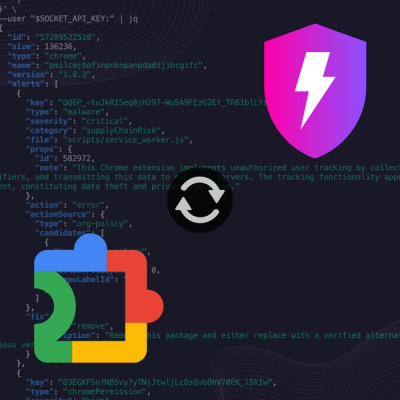
Product
Socket Now Protects the Chrome Extension Ecosystem
Socket is launching experimental protection for Chrome extensions, scanning for malware and risky permissions to prevent silent supply chain attacks.
SYNOPSIS zonify ... (-h|-[?]|--help) ... zonify ec2 * > zone.ec2.yaml zonify ec2/r53 * > changes.yaml zonify r53 > zone.r53.yaml zonify diff zone.r53.yaml zone.ec2.yaml > changes.yaml zonify rewrite * < zone.ec2.yaml zonify summarize < changes.yaml zonify apply < changes.yaml zonify sync * zonify normalize zonify eips
DESCRIPTION The zonify tool allows one to create DNS entries for all instances, tags and load balancers in EC2 and synchronize a Route 53 zone with these entries.
The zonify tool and libraries intelligently insert a final and initial
'.' as needed to conform to DNS conventions. One may enter the domains
at the command line as example.com or example.com.; it will work either
way.
For access to AWS APIs, zonify uses the the conventional environment
variables to select regions and specify credentials:
AWS_ACCESS_KEY AWS_ACCESS_KEY_ID
AWS_SECRET_KEY AWS_SECRET_ACCESS_KEY
EC2_URL
These variables are used by many AWS libraries and tools. As a conve-
nience, the environment variable AWS_REGION may be used with region
nicknames:
AWS_REGION=eu-west-1
One may specify --use-iam-profile option to configure the zonify tool
with AWS IAM-provided access and secret keys. This capability is avail-
able only when running the tool on an EC2 instance with an IAM role.
The Zonify subcommands allow staged generation, transformation and
auditing of entries as well as straightforward, one-step synchroniza-
tion.
ec2 (--srv-singleton|--no-srv-singleton)?
Organizes instances, load balancers, security groups and
instance metadata into DNS entries, with the generic suffix
'.' (intended to be transformed by later commands).
ec2/r53 (--types CNAME,SRV)? (--srv-singleton|--no-srv-singleton)?
Creates a changes file, describing how records under the
given suffix would be created and deleted to bring it in to
sync with EC2. By default, only records of type CNAME and SRV
are examined and changed.
r53 Capture all Route 53 records under the given suffix.
diff (--types CNAME,SRV,A,MX,...)?
Describe changes (which can be fed to the apply subcommand)
needed to bring a Route 53 domain in the first file into sync
with domain described in the second file. The suffix is taken
from the first file. The default with diff (unlike other
zonify subcommands) is to examine all record types.
rewrite (--srv-singleton|--no-srv-singleton)?
Apply rewrite rules to the domain file.
summarize
Summarize changes in a changes file, writing to STDOUT.
apply Apply a changes file.
sync (--types CNAME,SRV)? (--srv-singleton|--no-srv-singleton)?
Sync the given domain with EC2. By default, only records of
type CNAME and SRV are examined and changed.
normalize
Create CNAMEs for SRV records that have only one server in
them and rebase records on to the given domain.
eips List all Elastic IPs and DNS entries that map to them.
The --[no-]srv-singleton options control creation of CNAMEs for single-
ton SRV records. They are enabled by default; but it can be useful to
disable them for pre-processing the YAML and then adding them with nor-
malize. For example:
zonify r53 amz.example.com > r53.yaml
zonify ec2 --no-srv-singleton > ec2.yaml
my-yaml-rewriter < ec2.yaml > adjusted.yaml
zonify normalize amz.example.com < adjusted.yaml > normed.yaml
zonify diff --types CNAME,SRV r53.yaml normed.yaml | zonify apply
The --[no-]srv-singleton options also control creation of weighted
round-robin CNAMEs, an infelicity in nomenclature.
SYNC POLICY Zonify assumes the domain given on the command line is entirely under the control of Zonify; records not reflecting the present state of EC2 are scheduled for deletion in the generated changesets. This can be controlled to some degree with the --types option.
The sync scopes over the domain and not necessarily the entire Route 53
zone. Say, for example, one has example.com in a Route 53 zone and one
plans to use amz.example.com for Amazon instance records. In this sce-
nario, Zonify will only specify changes that delete or create records
under amz.example.com; www.example.com, s0.mobile.example.com and simi-
lar records will not be affected.
YAML OUTPUT All records and change sets are sorted by name on output. The data com- ponents of records are also sorted. This ensures consistent output from run to run; and allows the diff tool to return meaningful results when outputs are compared.
One exception to this rule is the r53 subcommand, which preserves the
order of data as it was found in Route 53.
REWRITE RULES Rewrite rules take the form (:)+. To shorten names under the apache security group to web.amz.example.com, use:
apache.sg:web
To keep both forms, use the rule:
apache.sg:apache.sg:web
GENERATED RECORDS AND QUERYING For records where there are potentially many servers -- security groups, tags, load balancers -- Zonify creates SRV records. When a SRV record has only one entry under it, a simple CNAME is created. When a SRV record contains multiple records, multiple weighted round-robin CNAMEs are created, one for each server in the SRV record.
Records created include:
i-ABCD1234.inst.
Individual instances.
_*._*.<value>.<key>.tag.
SRV records for tags.
_*._*.<name>.sg.
SRV records for security groups.
_*._*.<name>.elb
SRV records for instances behind Elastic Load Balancers.
domU-*.priv., ip-*.priv
Records pointing to the default hostname, derived from the
private DNS entry, set by many AMIs.
A list of all instances is placed under inst -- continuing with our
example above, this would be the SRV record _*._*.inst.amz.example.com.
To obtain the list of all instances with dig:
dig @8.8.8.8 +tcp +short _*._*.inst.amz.example.com SRV | cut -d' ' -f4
The cut call is necessary to remove some values, always nonces with
Zonify, that are part of standard format SRV records.
EXAMPLES # Create records under amz.example.com, with instance names appearing # directly under .amz.example.com. zonify sync amz.example.com name.tag:. # Similar to above but stores changes to disk for later application. zonify ec2/r53 amz.example.com name.tag:. > changes.yaml
FAQs
Unknown package
We found that zonify demonstrated a not healthy version release cadence and project activity because the last version was released a year ago. It has 1 open source maintainer collaborating on the project.
Did you know?

Socket for GitHub automatically highlights issues in each pull request and monitors the health of all your open source dependencies. Discover the contents of your packages and block harmful activity before you install or update your dependencies.

Product
Socket is launching experimental protection for Chrome extensions, scanning for malware and risky permissions to prevent silent supply chain attacks.

Product
Add secure dependency scanning to Claude Desktop with Socket MCP, a one-click extension that keeps your coding conversations safe from malicious packages.

Product
Socket now supports Scala and Kotlin, bringing AI-powered threat detection to JVM projects with easy manifest generation and fast, accurate scans.